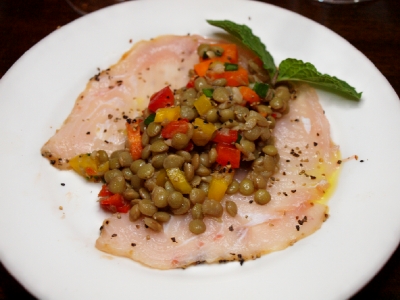
Our annual survey of seafood in Southeast Louisiana this year counts down the 33 best seafood species enjoyed in our restaurants, seafood markets, and homes. For the full survey so far, click here. Or use the links at the bottom to move up and down the list.

#29: Swordfish
The well-named swordfish has been returning to menus and fish markets in recent years, after a brush with overfishing a decade ago. Management of the stocks in the Atlantic has made swordfish populations tenable again. If the program keeps up, the average swordfish--much smaller than it once was, will get bigger, too. The recreational fishing industry is a friend in this case, because swordfish are prized catches. A wall-mounted swordfish in the man-cave is a familiar cliche.
Swordfish can grow to be over a thousand pounds. More common are 100-to-300-pound specimens. A fish that big is not filleted, but steaked. A piece of swordfish resembles that of tuna in every way but color; the swordfish has a silvery bronze look. Swordfish contains less fat than tuna, but for some reason it doesn't get tough unless you really overcook it. If you're interested in a steak-like fish but can't get your head around a raw interior, sword is the fish for you.
While all kinds of restaurants serve swordfish, I've always found Italian chefs do the best work with the species. ("Pesce spada" is the Italian name for the fish.) Particularly when grilled and served with the light, herbal sauces made from olive oil, garlic, crushed red pepper and herbs, swordfish shows off its unique flavors best.
If there's a problem with eating swordfish, it's in its higher-than-average mercury content. That a result of its being at the top of the ocean food chain. But it's no worse in that regard than tuna. Just don't eat it all the time.

Andrea's Swordfish Padova
If you want to eat swordfish, your best bet is to go to an Italian restaurant. Pesce spada, as they call it, is a favorite fish of Italian chefs, both here and there. This version is by Chef Andrea Apuzzo, from the cookbook of his recipes that I wrote with him in 1989.
Swordfish are huge and their fillets are usually cut into steaks. Like tuna, should not be cooked until it's gray all the way through; that will make it tough and unappealing. Use steaks at least an inch thick.
- Marinade:
- 1/4 cup extra-virgin olive oil
- 1/4 cup dry white wine
- 1 tsp. Worcestershire sauce
- 1 Tbs. lemon juice
- 3-5 dashes Tabasco
- Coating:
- 1/2 cup flour
- 1 tsp. salt
- 1/4 tsp. white pepper
- 4 swordfish steaks, 8 oz. each
- 3 Tbs. olive oil
- 1 Tbs. chopped onions
- 2 tsp. chopped garlic
- 1/2 cup dry white wine
- 1/4 cup dry vermouth
- 1/2 cup fish stock (or oyster liquor)
- 1/2 tsp. fresh thyme leaves
- 5 leaves chopped fresh basil
- 5 sun-dried tomatoes, sliced julienne
- 1 tsp. salt
- 1/4 tsp. white pepper
1. Blend the fish marinade in a large, shallow platter. Marinate the fish for about a minute on each side, then drain excess marinade.
2. Blend the coating ingredients, and use it to dust the fish on both sides, lightly.
3. Heat 1 Tbs. of olive oil in a skillet over medium heat. Cook the swordfish steaks in the skillet for just 45 seconds on each side--until very lightly browned in spots. Remove from the skillet and keep fish warm.
4. To the same skillet over medium heat, add the rest of the olive oil and saute the onions and garlic until lightly browned. Add wine, vermouth, fish stock, thyme, sun-dried tomatoes, basil, salt and pepper. Bring to a rapid simmer, then return the swordfish to the skillet. Cook until the sauce permeates the fish--just about 30 seconds--and serve.
.
Serves four.